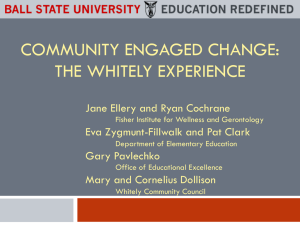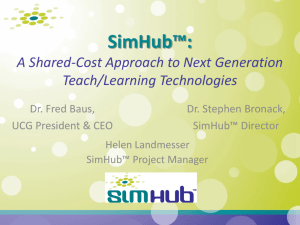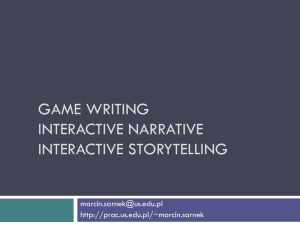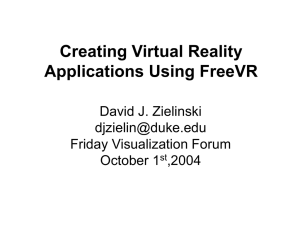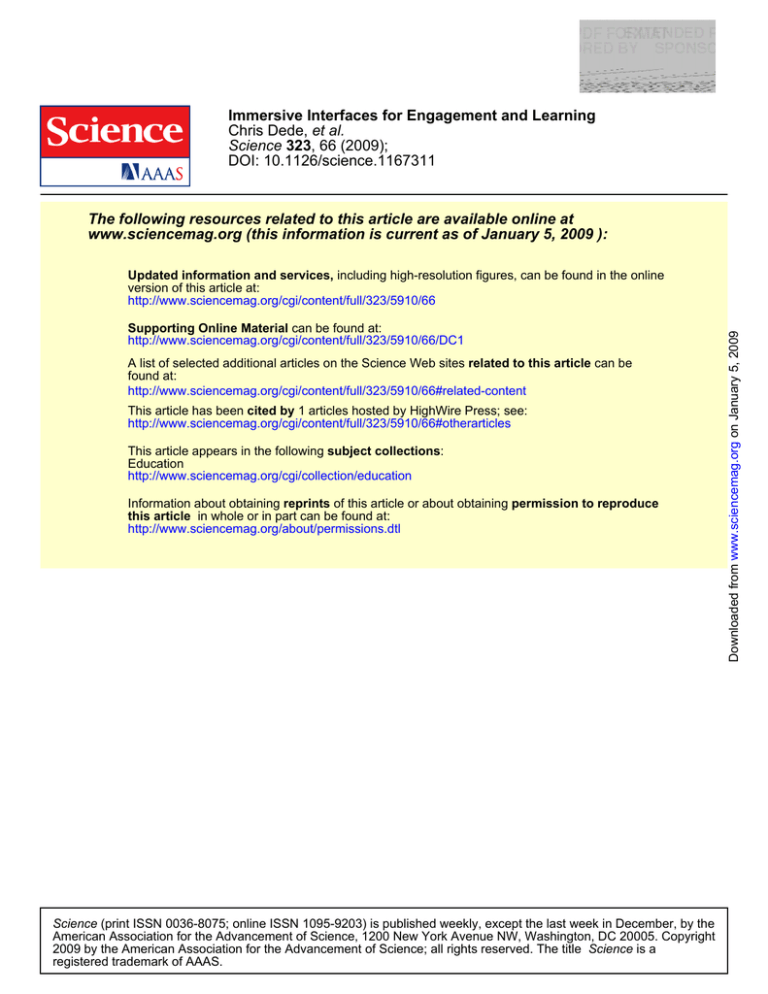
Immersive Interfaces for Engagement and Learning
Chris Dede, et al.
Science 323, 66 (2009);
DOI: 10.1126/science.1167311
The following resources related to this article are available online at
www.sciencemag.org (this information is current as of January 5, 2009 ):
Supporting Online Material can be found at:
http://www.sciencemag.org/cgi/content/full/323/5910/66/DC1
A list of selected additional articles on the Science Web sites related to this article can be
found at:
http://www.sciencemag.org/cgi/content/full/323/5910/66#related-content
This article has been cited by 1 articles hosted by HighWire Press; see:
http://www.sciencemag.org/cgi/content/full/323/5910/66#otherarticles
This article appears in the following subject collections:
Education
http://www.sciencemag.org/cgi/collection/education
Information about obtaining reprints of this article or about obtaining permission to reproduce
this article in whole or in part can be found at:
http://www.sciencemag.org/about/permissions.dtl
Science (print ISSN 0036-8075; online ISSN 1095-9203) is published weekly, except the last week in December, by the
American Association for the Advancement of Science, 1200 New York Avenue NW, Washington, DC 20005. Copyright
2009 by the American Association for the Advancement of Science; all rights reserved. The title Science is a
registered trademark of AAAS.
Downloaded from www.sciencemag.org on January 5, 2009
Updated information and services, including high-resolution figures, can be found in the online
version of this article at:
http://www.sciencemag.org/cgi/content/full/323/5910/66
PERSPECTIVE
Immersive Interfaces for
Engagement and Learning
Chris Dede
Immersion is the subjective impression that one is participating in a comprehensive, realistic
experience. Interactive media now enable various degrees of digital immersion. The more a virtual
immersive experience is based on design strategies that combine actional, symbolic, and sensory
factors, the greater the participant’s suspension of disbelief that she or he is “inside” a digitally
enhanced setting. Studies have shown that immersion in a digital environment can enhance
education in at least three ways: by allowing multiple perspectives, situated learning, and transfer.
Further studies are needed on the capabilities of immersive media for learning, on the instructional
designs best suited to each type of immersive medium, and on the learning strengths and
preferences these media develop in users.
s another article in this special issue
discusses, the information technologies
used by children during their formative
years influence their learning strengths and preferences (1). An increasingly prevalent type of
media, immersive interfaces, can aid in designing
educational experiences that build on students’
digital fluency to promote engagement, learning, and transfer from classroom to real-world
settings.
A
Inducing a participant’s symbolic immersion
involves triggering powerful semantic, psychological associations by means of the content of
an experience. As an illustration, digitally fighting a terrifying, horrible virtual monster can
build a mounting sense of fear, even though
one’s physical context is unchanging and rationally safe. Invoking digital versions of archetypical situations from one’s culture deepens the
Immersive Presence
Immersion is the subjective impression that one is participating in a comprehensive, realistic
experience (2, 3). Immersion in
a digital experience involves
the willing suspension of disbelief, and the design of immersive learning experiences that
induce this disbelief draws on
sensory, actional, and symbolic
Fig. 1. (A) Exocentric view of NewtonWorld. (B) Egocentric view
factors (4). Sensory immersion
replicates digitally the experience of location inside a three-dimensional space; immersive experience by drawing on the partictotal sensory interfaces utilize either head-mounted ipant’s beliefs, emotions, and values about the
displays or immersive virtual reality rooms, stereo- real world. The more a virtual immersive expescopic sound, and—through haptic technologies rience is based on design strategies that combine
that apply forces, vibrations, and motions to the actional, symbolic, and sensory factors, the greater
user—the ability to touch virtual objects. As the participant’s suspension of disbelief that she
described below, interactive media now enable or he is “inside” a digitally enhanced setting.
various degrees of sensory immersion.
Actional immersion involves empowering the Immersion Enhances Learning Through
participant in an experience to initiate actions Multiple Perspectives
impossible in the real world that have novel, According to studies, immersion in a digital
intriguing consequences. For example, when a environment can enhance education in at least
person playing an Internet game can make new three ways: by enabling multiple perspectives,
discoveries by becoming a bird and flying situated learning, and transfer. First, the ability
around, the degree of concentration this activity to change one’s perspective or frame of reference
is a powerful means of understanding a complex
creates is intense.
phenomenon. Typically, this is done by shifting
between an exocentric and an egocentric frame
Graduate School of Education, Harvard University, Camof reference. The exocentric frame of reference
bridge, MA 02138, USA. E-mail: chris_dede@harvard.edu
66
2 JANUARY 2009
VOL 323
SCIENCE
(Fig. 1A) provides a view of an object, space, or
phenomenon from the outside; the egocentric
frame of reference (Fig. 1B) provides a view from
within the object, space, or phenomenon. With
funding from the National Science Foundation
(NSF), in the 1990s, our Project ScienceSpace
research team conducted studies on sensory
immersion in frames of reference and found that
the exocentric and the egocentric perspectives
have different strengths for learning (5) (SOM
Text 1).
A major advantage of egocentric perspectives is that they enable participants’ actional
immersion and motivation through embodied,
concrete learning, whereas exocentric perspectives foster more abstract, symbolic insights
gained from distancing oneself from the context
(seeing the forest rather than the trees). Bicentric
experiences that alternate these views combine
these strengths.
Immersion Enhances Learning Through
Situated Experience
Immersive interfaces can foster educational experiences that draw on a powerful pedagogy:
situated learning. Situated learning requires authentic contexts, activities, and assessment coupled
with guidance from expert modeling, mentoring,
and “legitimate peripheral participation” (6, 7).
As an example of legitimate peripheral participation, physical
science graduate students work
within the laboratories of expert
researchers, who model the practices of scholarship in field work
and laboratory work. These students tacitly learn through watching
experts in research, as well as by
interacting with other team members who understand sophisticated
scholarship to varying degrees.
While in these settings, students
inside a ball.
gradually move from novice researchers to more advanced roles,
with other team members’ expectations for them
evolving as their skills develop.
Potentially quite powerful, situated learning
is seldom used in classroom instruction because
arranging complementary, tacit, relatively unstructured learning in complex real-world settings is
difficult. However, immersive interfaces can draw
on the power of situated learning by enabling
digital simulations of authentic problem-solving
communities in which learners interact with other
virtual entities (both participants and computerbased agents) who have varied levels of skills.
As discussed in another article in this special
issue, scholars are studying the extent to which
Internet games and virtual environments such as
Second Life provide situated learning that leads
to knowledge useful in the real world; their
findings thus far are promising (8, 9). The research my colleagues and I are conducting on
www.sciencemag.org
Downloaded from www.sciencemag.org on January 5, 2009
Education & Technology
SPECIALSECTION
measures (such as a letter to River City’s mayor
describing an intervention to help reduce illness
and providing evidence to support this claim).
Digital immersion allows these students to build
confidence in their academic abilities by stepping
out of their real-world identity of poor performer
academically, which shifts their frame of selfreference to successful scientist in the virtual context. This suggests that immersive media may
have the potential to release trapped intelligence
and engagement in many learners, if we can
understand how best to design instruction using
this type of immersive, simulated experience.
Other researchers who study educational
multiuser virtual environments designed for
young people, such as Quest Atlantis or Whyville
(13, 14), also are finding that immersive digital
settings enhance their participants’ engagement
and learning. Research indicates that active learning based on immersive situated experiences that
include frequent opportunities for reflection via
combining egocentric and exocentric perspectives
(e.g., participant inside River City versus external
observer of the town’s overall dynamics) is both
motivating and powerful for a broad spectrum of
students. The success of immersive simulations
in corporate and military training (15, 16) suggests that these positive findings also apply to
learners considerably older than those we study.
Immersion may enhance transfer through
simulation of the real world. Situated learning
through immersive interfaces is important in
part because of the crucial issue of transfer.
Transfer is defined as the application of knowledge learned in one situation to another situation
and is demonstrated if instruction on a learning
task leads to improved performance on a transfer task, ideally a skilled performance in a realworld setting (17).
Researchers differentiate between two ways
of measuring transfer: sequestered problemsolving and preparations for future learning
(18). Sequestered problem-solving tends to focus
on direct applications that do not provide an op-
portunity for students to utilize resources in their
environment (as they would in the real world);
standardized tests are an example of this. Giving
students presentational instruction that demonstrates solving standard problems, then testing
their ability to solve similar problems involves
near-transfer: applying the knowledge learned in
a situation to a similar context with somewhat
different surface features.
When evaluation is based on the success of
learning as a preparation for future learning,
researchers measure transfer by focusing on extended performances where students “learn how
to learn” in a rich environment and then solve
related problems in real-world contexts. With
conventional instruction and problem-solving,
attaining preparation for future learning requires
far-transfer: applying knowledge learned in a situation to a quite different context whose underlying semantics are associated, but distinct.
One of the major criticisms of instruction today
is the low rate of far-transfer generated by presentational instruction. Even students who excel in
educational settings often are unable to apply what
they have learned to similar real-world contexts.
The potential advantage of immersive interfaces
for situated learning is that their simulation of realworld problems and contexts means that students
must attain only near-transfer to achieve preparation for future learning. Flight and surgical simulators demonstrate near-transfer of psychomotor
skills from digital simulations to real-world settings; a variety of studies are currently under way
to assess whether other types of immersive learning show transfer to the real world to some degree.
Downloaded from www.sciencemag.org on January 5, 2009
gamelike virtual simulations for educating
young people about higher-order inquiry skills
illustrates how immersion can aid engagement
and educational achievement through situated
learning.
The NSF-funded River City multiuser virtual
environment is centered on skills of hypothesis
formation and experimental design, as well as on
content related to national standards and assessments in biology and epidemiology (10). Students
learn to behave as scientists as they collaboratively
identify problems through observation and inference,
form and test hypotheses, and deduce evidencebased conclusions about underlying causes. Learners
immerse themselves inside a simulated, historically
accurate 19th-century city (Fig. 2A). Collaborating in
teams of three or four participants, they try to figure
out why people are getting sick and what actions can
remove sources of illness. They talk to various residents in this simulated setting, such as children
and adults who have fallen ill, hospital employees, merchants, and university scientists (Fig. 2B
and SOM Text 2).
Our research results from River City show
that a broader range of students gain substantial knowledge and skills in scientific inquiry
through immersive simulation than through conventional instruction or equivalent learning experiences delivered via a board game. Our
findings indicate that students are deeply engaged
by this curriculum through actional and symbolic
immersion and are developing sophisticated
problem-finding skills (in a complex setting
with many phenomena, problems must be identified and formulated before they can be solved).
Compared with a similar, paper-based curriculum that included laboratory experiences, students overall (regardless of factors such as gender,
ethnicity, or English language proficiency) were
more engaged in the immersive interface and
learned as much or more (11, 12).
Many academically low-performing students do as well as their high-performing peers
in River City, especially on performance-based
Lesser Degrees of Immersion Can Still Provide
Situated Learning
Our research team is currently studying augmented reality, in which users are immersed in a
mixture of real and virtual settings. Participants
in these immersive simulations use location-aware
handheld computers [generally with global positioning system (GPS) technology], which allow
Fig. 2. (A) River City. (B) Avatar talking to agent.
www.sciencemag.org
SCIENCE
VOL 323
2 JANUARY 2009
67
users to physically move throughout a real-world
location while collecting place-dependent simulated field data, interviewing virtual characters, and
collaboratively investigating simulated scenarios
(19). Today, augmented reality relies on coupling a
handheld computing device to a GPS receiver;
however, in the near future, sophisticated cellular phones will provide a ubiquitous infrastructure for this type of immersive learning.
The Handheld Augmented Reality Project,
funded by U.S. Department of Education, is part
of a collaborative effort by Harvard University,
the University of Wisconsin, and the Massachusetts Institute of Technology to study the
efficacy of augmented-reality technology for
instruction in math and language arts at the
middle-school level. Alien Contact! is a curriculum my research team designed to teach
math and literacy skills to middle- and highschool students. (20) This narrative-driven, inquirybased augmented-reality simulation is played on
a Dell Axim X51 handheld computer and uses
GPS technology to correlate the students’ real
world location to their virtual location in the
simulation’s digital world (Fig. 3A).
As the students move around a physical location, such as their school playground or sports
fields (Fig. 3B), a map on their handheld displays
digital objects and virtual people who exist in a
simulated world superimposed on real space
(Fig. 4). When students come close to these digital
artifacts, the augmented reality and GPS software
triggers video-, audio-, and text files, which pro-
vide narrative, navigation and collaboration cues,
as well as academic challenges to build math and
literacy skills (SOM Text 3).
Early research on the Alien Contact! curriculum found high levels of student engagement,
as well as educational outcomes in literacy and
math equivalent to students playing a similar,
engaging board game as a control condition
(21). Further design-based research is needed
to determine the extent to which more powerful
learning outcomes emerge from augmentedreality experiences. Such studies will aid in determining what degree of digital immersion is
necessary for achieving various types of engagement, learning, and transfer.
Next steps in research on immersive interfaces
for learning. Due to the growing ubiquity of sophisticated mobile phones and multiplayer Internet
games, people of all ages increasingly will have
life-style choices involving engaging forms of immersion in both virtual and augmented realities.
Understanding the strengths and limits of these
immersive media for education is important, particularly because situated learning seems a promising method for learning sophisticated cognitive
skills, such as using inquiry to find and solve
problems in complicated situations.
Further studies are needed on the affordances
immersive media offer for learning, on the instructional designs best suited to each type of
immersive medium, and on the learning strengths
and preferences use of these media develops in
users. Illustrative research questions include:
Fig. 3. (A) Dell Axim and GPS receiver. (B) Students exploring school grounds.
Fig. 4. Handheld display of digital resources on school grounds.
68
2 JANUARY 2009
VOL 323
SCIENCE
• To what extent does good instructional
design for immersive environments vary depending on the subject matter taught or on the
characteristics of the learner? For what types of
curricular material is full sensory immersion
important?
• To what extent can the successes of one’s
virtual identity in immersive environments induce greater self-efficacy and educational progress in the real world?
• To attain transfer, what is the optimal
blend of situated learning in real, augmented,
and virtual settings?
• What insights about bicentric frames of
reference can generalize from immersive environments to pedagogical strategies in face-toface settings?
Results from studies of immersive environments for learning seem sufficiently promising
that further investment in this type of research is
indicated.
References and Notes
1. J. Oblinger, D. Oblinger, Eds., Educating the Net
Generation (EDUCAUSE Publishers, Boulder, CO, 2005);
www.educause.edu/educatingthenetgen/.
2. K. M. Stanney, Handbook of Virtual Environments
(Erlbaum, Mahwah, New Jersey, 2002).
3. J. Lessiter, J. Freeman, E. Keogh, J. Davidoff, Presence
Teleoper. Virtual Environ. 10, 282 (2001).
4. C. Dede, M. Salzman, R. B. Loftin, K. Ash, in Innovations in
Science and Mathematics Education: Advanced Designs for
Technologies of Learning, M. J. Jacobson, R. B. Kozma,
Eds. (Erlbaum, Mahweh, NJ, 2000), pp. 361–413.
5. M. Salzman, C. Dede, R. B. Loftin, in Proceedings of the
SIGCHI Conference on Human Factors in Computing
Systems: The CHI Is the Limit, Pittsburgh, PA, 15 to 20
May 1999 (ACM Press, New York, 1999), pp. 489–495;
http://portal.acm.org/toc.cfm?id=302979&type=proceeding.
6. J. D. Bransford, A. L. Brown, R. R. Cocking, Eds.,
How People Learn: Brain, Mind, Experience, and School,
Expanded Edition (National Academies Press, Washington,
DC, 2000); www.nap.edu/books/0309070368/html/.
7. J. Clarke, C. Dede, in The 2007 Computer-Supported
Collaborative Learning (CSCL) Conference, C. A. Chinn,
G. Erkens, S. Putambekar, Eds., New Brunswick, NJ, 15 to
22 July 2007 (International Society for the Learning
Sciences, New Brunswick, NJ, 2007), pp. 141–144.
8. J. P. Gee, in The Ecology of Games: Connecting Youth,
Games, and Learning, K. Salen, Ed. (MIT Press,
Cambridge, MA, 2008), pp. 21–40.
9. C, Steinkuehler, S. Duncan, J. Sci. Educ. Technol. 17, 530
(2008).
10. J. Clarke, C. Dede, D. J. Ketelhut, B. Nelson, Educational
Technology 46, 27 (2006).
11. D. Ketelhut, C. Dede, J. Clarke, B. Nelson, C. Bowman,
in Assessment of Problem Solving Using Simulations,
E. Baker, J. Dickieson, W. Wulfeck, H. O’Neil, Eds.
(Erlbaum, Mahweh, NJ, 2007), pp. 37–58.
12. B. Nelson, J. Sci. Educ. Technol. 16, 83 (2007).
13. S. A. Barab, T. D. Sadler, C. Heiselt, D. Hickey, S. Zuiker,
J. Sci. Educ. Technol. 16, 59 (2007).
14. N. Neulight, Y. B. Kafai, L. Kao, B. Foley, C. Galas, J. Sci.
Educ. Technol. 16, 47 (2007).
15. R. C. Schank, Lessons in Learning, E-Learning, and
Training (Pfeiffer, San Francisco, CA, 2005)
16. M. Zyda, Computer 38, 25 (2005).
17. J. Mestre, Transfer of Learning: Issues and a Research
Agenda (National Science Foundation, Washington, DC,
2002); www.nsf.gov/pubs/2003/nsf03212/start.htm.
18. D. L. Schwartz, D. Sears, J. D. Bransford, in Transfer of
Learning from a Modern Multidisciplinary Perspective,
www.sciencemag.org
Downloaded from www.sciencemag.org on January 5, 2009
Education & Technology
SPECIALSECTION
21. P. O’Shea, R. Mitchell, C. Johnston, C. Dede, Int. J.
Gaming Comput. Mediat. Simul. 1 (1), 1 (2008).
22. My research team’s studies of virtual reality and
multiuser virtual environments (MUVEs) are funded by
the NSF, and our research on augmented reality is
funded by the U.S. Department of Education. Any
opinions, findings, and conclusions or recommendations
expressed in this material are those of the author and do
PERSPECTIVE
Technology and Informal Education:
What Is Taught, What Is Learned
Patricia M. Greenfield
The informal learning environments of television, video games, and the Internet are producing learners with a
new profile of cognitive skills. This profile features widespread and sophisticated development of visual-spatial
skills, such as iconic representation and spatial visualization. A pressing social problem is the prevalence
of violent video games, leading to desensitization, aggressive behavior, and gender inequity in opportunities
to develop visual-spatial skills. Formal education must adapt to these changes, taking advantage of new
strengths in visual-spatial intelligence and compensating for new weaknesses in higher-order cognitive
processes: abstract vocabulary, mindfulness, reflection, inductive problem solving, critical thinking, and
imagination. These develop through the use of an older technology, reading, which, along with audio
media such as radio, also stimulates imagination. Informal education therefore requires a balanced media
diet using each technology’s specific strengths in order to develop a complete profile of cognitive skills.
nformal education—what goes on outside
of the classroom—shapes our thought processes as they develop from early childhood.
Media technologies are an extremely important part of informal learning environments.
Media are also part of formal learning environments, the subject of other papers in this
special issue on educational technology. The
technologies composing the informal learning
environment are generally intended for entertainment rather than education. However, they
are important sources of cognitive socialization,
often laying the foundation for knowledge acquisition in school.
In the midst of much press about the decreasing use of the print medium and failing
schools, a countervailing trend may come as a
surprise: the continuing global rise in IQ performance over more than 100 years. This rise,
known as the Flynn effect, is concentrated in
nonverbal IQ performance (mainly tested through
visual tests) but has also occurred, albeit to a lesser
extent, in verbal IQ (1–5). Rising IQ performance
is attributable to multiple factors: increased levels
of formal education, urbanization, societal complexity, improved nutrition, smaller family size,
and technological development (5–7). These
are interrelated rather than independent factors; they are part and parcel of the worldwide
movement from smaller-scale, low-tech com-
I
Department of Psychology, University of California, Los Angeles,
CA 90095, USA.
not necessarily reflect the views of these funding
agencies.
Supporting Online Material
www.sciencemag.org/cgi/content/full/323/5910/66/DC1
SOM Text
Figs. S1 to S7
10.1126/science.1167311
Evidence for the Flynn Effect
Among several kinds of test data from 20
industrialized countries, Flynn compared
records of British people tested in 1942 and
1992 on Raven Progressive Matrices (Fig.
1 shows a sample item). Between 1942 and
1992, average performance increased for all age
groups (Fig. 2) (4). Note that the oldest members
of the first cohort tested grew up in the last two
decades of the 19th century, extending the baseline
back that far.
The new organization of Flynn’s data in
Fig. 2 reveals another important point: Not only
is performance on the matrices better in the later cohort but cognitive aging is also reduced—
witness an almost flat slope of performance
across the age groups tested in 1992. This slope
contrasts with the age-related decline seen in the
groups tested in 1942.
Male military recruits supplied most of Flynn’s
data, skewing samples toward a relatively low
socioeconomic population and excluding women. A University of California, Los Angeles, team
(5) later demonstrated the Flynn effect in rural
Downloaded from www.sciencemag.org on January 5, 2009
J. Mestre, Ed. (Information Age, Greenwich, CT, 2005),
pp. 1–51.
19. E. Klopfer, Augmented Reality: Research and Design of
Mobile Educational Games (MIT Press, Cambridge, MA,
2008).
20. M. Dunleavy, C. Dede, R. Mitchell, J. Sci. Educ. Technol.,
10.1007/s10956-008-9119-1, published online
8 September 2008.
munities with subsistence economies toward
larger-scale, high-tech societies with commercial economies (8). Which specific factor is
most important in raising
IQ performance at a given
time and place depends on
the locus of social change
occurring then and there
(6, 8). Increasing levels of
formal education and urbanization were particularly important in the United
States and Europe in the
first half of the 20th century
(9, 10). More recently, technological change may have
taken the dominant role.
1
2
3
The changing balance
of media technologies has
led to losses as well as gains.
For example, as verbal IQ
has risen, verbal SATs have
fallen. Paradoxically, omni4
5
6
present television may be
responsible for the spread
of the basic vocabulary (11)
that drives verbal IQ scores,
while simultaneously the decline in recreational reading Fig. 1. A simple item from Raven Standard Progressive Matrices. From
may have led to the loss of the six inserts at the bottom of the figure, the participant selects the one
the more abstract vocabulary that logically fits in the matrix above. [Figure A5 of the Raven Standard
driving verbal SAT scores Progressive Matrices, by J. C. Raven. Copyright 1938, 1976 by J. C. Raven
Ltd. Reprinted with permission]
(6, 12, 13).
www.sciencemag.org
SCIENCE
VOL 323
2 JANUARY 2009
69

